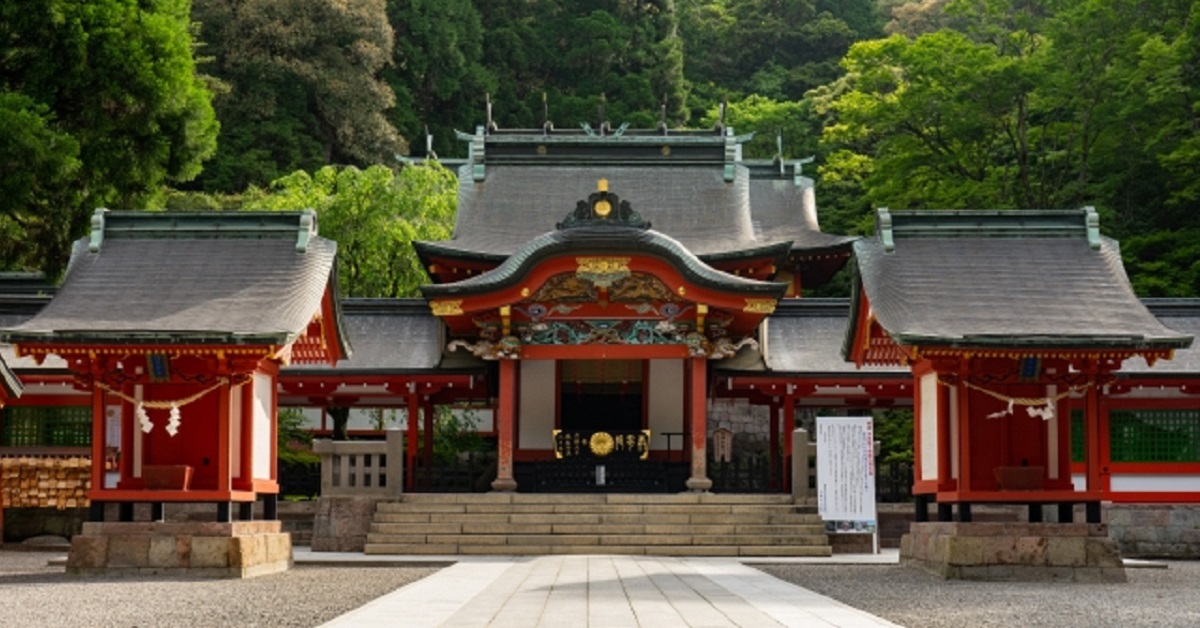Nestled in the mountains of Kagoshima, Kirishima Shrine is a National Treasure that embodies both ancient Japanese mythology and magnificent Edo-period architecture. Visitors are welcomed into a sacred space where nature, tradition, and spirituality coexist in harmony.
About Kirishima Shrine
Kirishima Shrine stands at the foot of Mount Takachiho in Kagoshima Prefecture. Its principal deity is Ninigi-no-Mikoto, who appears in the myth of the “Descent of the Heavenly Grandson” (Tenson Kōrin). This myth symbolizes the founding of Japan, and the mountains of Kirishima are said to be the stage of the story.
Although the shrine was repeatedly destroyed by volcanic activity, it was rebuilt each time. The current structures were completed during the Edo period under the support of the Satsuma domain. The bright vermilion halls form a striking contrast with the deep green forests, leaving a powerful impression on visitors.
Why it was Designated a National Treasure
On February 9, 2022, the main hall, offering hall, and worship hall of Kirishima Shrine were designated as a National Treasure. The reasons include:
- Advanced architectural techniques in its design
- Vivid decorative colors and intricate carvings
- Excellent preservation since the late Edo period
At the same time, Kagoshima Shrine in Kagoshima City was designated as an Important Cultural Property, reaffirming the historical significance of Southern Kyushu’s religious culture.
Architectural Features
Kirishima Shrine is built in the Gongen-zukuri style, in which the main hall, offering hall, and worship hall are connected in an integrated structure. The roof features graceful curves and is covered with cypress bark. Detailed carvings of dragons, phoenixes, and peonies express both sacredness and beauty.
| Section | Characteristics | Designation |
|---|---|---|
| Main Hall | Dragon and floral carvings, vivid colors | National Treasure |
| Offering Hall | Sacred space for rituals | National Treasure |
| Worship Hall | Place where visitors offer prayers | National Treasure |
| Torii Gate | Vermilion gate marking the entrance | Not designated |
| Corridor | Pathway connecting the halls | Not designated |
These structures are not only beautiful individually but also create a harmonious and solemn atmosphere when seen as a whole.
Kirishima Shrine and Japanese Mythology
Kirishima Shrine is a place where you can experience Japanese mythology firsthand. The enshrined deity, Ninigi-no-Mikoto, is the grandson of the sun goddess Amaterasu, who descended to earth to teach rice cultivation.
The grounds are filled with sites connected to mythology. On Mount Takachiho stands the legendary “Amano-Sakahoko” (Heavenly Spear), said to have been thrust into the ground by Ninigi-no-Mikoto during his descent, making it one of the most symbolic landmarks in Japanese mythology.
Seasonal Attractions
Kirishima Shrine presents different faces throughout the year, offering unforgettable scenery to international visitors.
| Season | Natural Beauty | Highlights |
|---|---|---|
| Spring | Cherry blossoms create a tunnel along the approach | Enjoy hanami with worship |
| Summer | Deep greenery and cool mountain air | Mystical forest walks |
| Autumn | Colorful foliage harmonizes with vermilion halls | Popular photography spot |
| Winter | Snow-covered shrine creates a dreamlike scene | Silent, sacred atmosphere |
The changing landscapes embody Japan’s cultural appreciation of the four seasons.
Appeal for International Visitors
For foreign travelers, Kirishima Shrine is more than a tourist attraction—it is a place to experience culture and nature together.
- Architectural beauty: Vivid halls and exquisite carvings
- Harmony with nature: Unique seasonal landscapes
- Spiritual culture: Mythological narratives and centuries of worship
These elements combine to provide a unique experience unavailable elsewhere. Additionally, nearby hot spring resorts enhance the visit, allowing travelers to enjoy both spiritual and physical relaxation.
Surrounding Attractions
Kirishima Shrine is even more rewarding when combined with nearby attractions.
| Attraction | Characteristics | Distance |
|---|---|---|
| Kirishima Onsen Village | Variety of hot springs with different qualities | About 20 min by car |
| Mount Takachiho | Sacred mountain of the descent myth | About 30 min by car |
| Kagoshima Shrine | Designated Important Cultural Property | About 40 min by car |
| Sakurajima | Active volcano with powerful scenery | About 90 min by car + ferry |
This makes it possible to design a journey that combines history, nature, and hot springs in one itinerary.
Regional Culture and Kirishima Shrine
Kirishima Shrine has long been the cultural heart of the region. Throughout the year, traditional festivals take place, featuring sacred dances and kagura performances. These are not merely religious rituals but also living cultural traditions deeply connected to local life.
Historically, the shrine was supported by the Satsuma domain. Its lords prayed there for national stability and good harvests. This history continues to shape Kagoshima’s culture, and for locals, the shrine remains a source of great pride.
Conclusion
Kirishima Shrine is a National Treasure with magnificent architecture and also a sacred stage of Japanese mythology. Blending seasonal nature, history, and spirituality, it offers an unparalleled cultural experience for international visitors.
By visiting, travelers can touch the core of Japanese culture and experience a unique space where nature and faith coexist. Kirishima Shrine is truly one of Japan’s most important cultural heritages, and its value will only continue to spread across the world.






